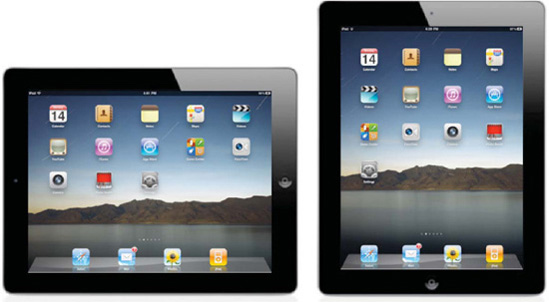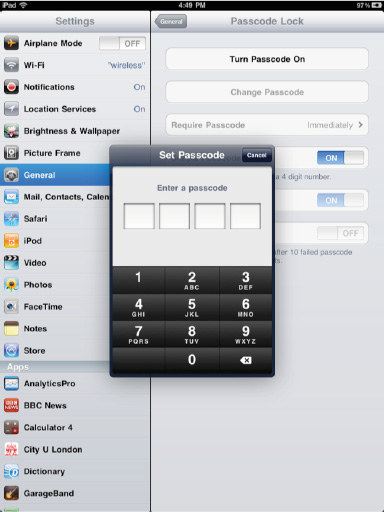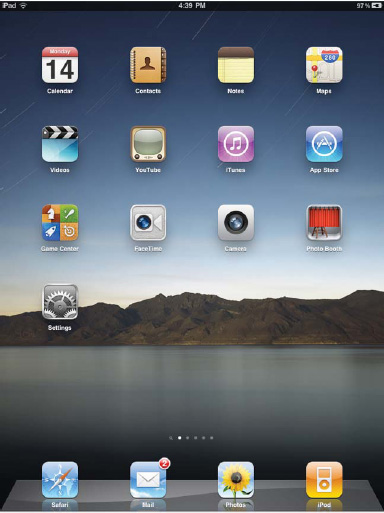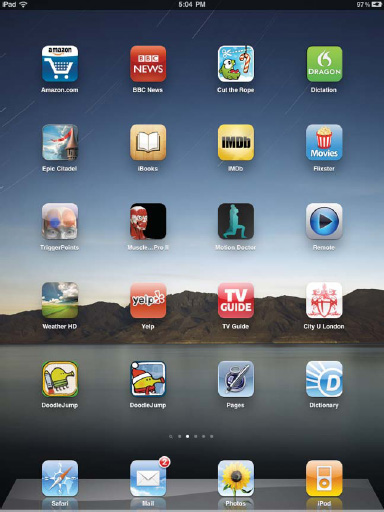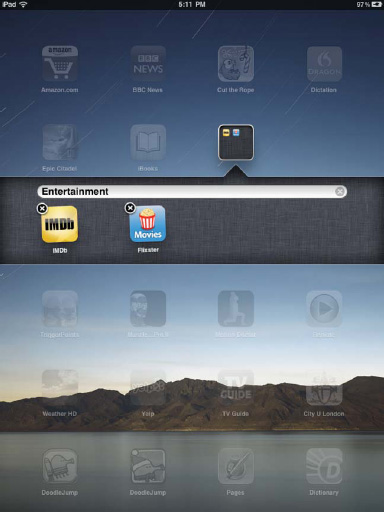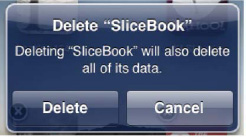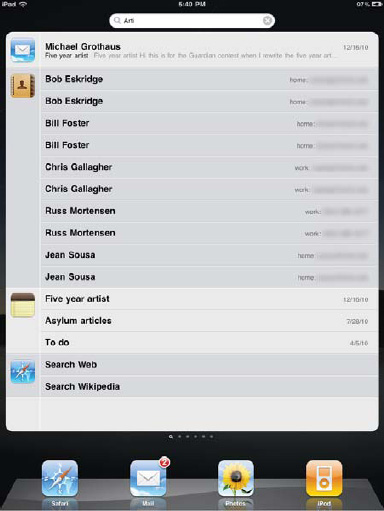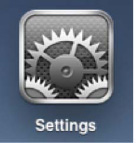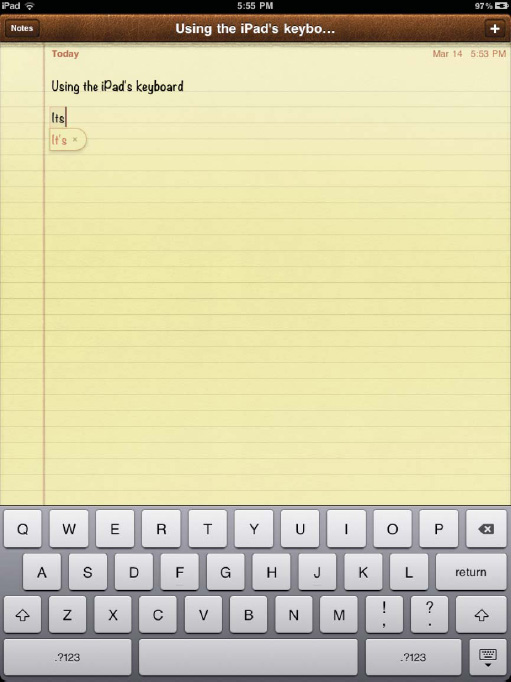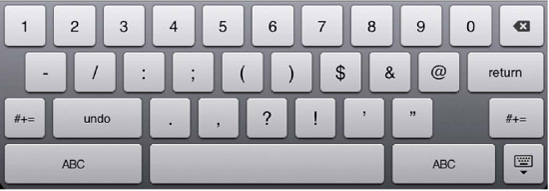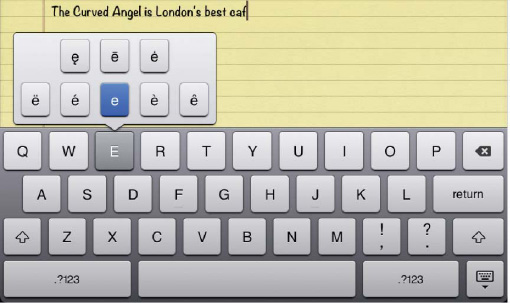For those of you who have used an iPhone or iPod touch, you'll already have some idea of how to interact with your iPad. However, because of the iPad's large screen, you'll find some subtle differences between the iPhone and your iPad. Never used an iPod touch or iPhone before? That's okay too, because you are absolutely going to be blown away by the iPad's Multi-Touch screen. The iPad responds to the language of your touch. Its vocabulary includes taps, drags, pinches, and flicks. With these actions, you control your iPad as easily as using a mouse to control your personal computer. And there's a lot more to interaction than just drags and taps. Your iPad offers Multi-Touch technology. That means it can recognize and respond to more than one touch at a time.
In this chapter, you'll discover all the different ways you can interact with your iPad—from zooming into and out of pictures to using the iPad's large built-in keyboard to setting Accessibility options. Let's get started.
Personal computers have mice. Personal digital assistants (PDAs) have styluses. The iPad has your fingers. It does not work with mice or styluses. It requires real finger contact. Your iPad does not just sense pressure points. It detects the small electrical charge transferred from your fingers. That means you can use your iPad with your fingers, your knuckles, or even—if you're feeling up to it—your nose, but you cannot use it with pencil erasers, Q-Tips, or those PDA styluses. The electrical charges in your touch make it possible for the iPad to detect and respond to one or more contacts at a time, that is, to use Multi-Touch technology.
Tip
If you're feeling really adventurous, you can use a frozen hotdog in place of your finger. Korean winters are very cold, and people were getting frostbite on their fingers from removing their gloves to use their iPhones outside. Some enterprising people in Korea discovered that you could use a frozen hotdog in lieu of your finger and still be able to interact with the iPhone's touch screen, all while keeping their gloves on. Theoretically, a frozen hotdog should work with the iPad's screen as well.
How you touch your iPad's screen provides your communication vocabulary. Here's a quick rundown of the basic ways you can speak to your iPad:
Pressing the Home button: The Home button lives below the touch screen and is marked with a white square. Press this button at any time while in an app to return to your Home screen with its list of applications. Double-pressing the Home button while on a home screen or while inside an app will bring up the multitasking bar. We'll talk more about multitasking later in this chapter.
Tapping: Tap your iPad by touching your finger to the screen and removing it quickly. Tapping allows you to select web links, activate buttons, and launch applications. When typing text, you may want to tap with your forefinger or, if it's more comfortable, your thumb.
Double-tapping: Double-tapping means tapping your screen twice in quick succession. Double-clicking may be important on your personal computer, but double-tapping is not actually used all that much on your iPad. You can double-tap in Safari (the web browser that ships on your iPad) to zoom into columns and double-tap again to zoom back out. In Photos (the iPad's built-in photo viewer), use double-tapping to zoom into and out from pictures.
Two-fingered tapping and dragging: The iPad's Multi-Touch technology means you can tap the screen with more than one finger at a time. A few applications respond to two-fingered gestures. To do this, separate your forefinger and middle finger and tap or drag the screen with both fingers at once. For example, in Safari, a double-fingered drag allows you to scroll within a web frame without affecting the page as a whole.
Holding: At times, you'll want to put your finger on the screen and leave it there until something happens. For example, holding brings up the spyglass while you're typing, and in Safari, it brings up URL previews.
Dragging: Drag your finger by pressing it to the screen and moving it in any direction before lifting it. Use dragging to scroll up and down in Safari and iPod (the application that plays your iTunes songs). Some applications offer an index on the right side, like the one shown for the iPod app in Figure 4-1. To use this index, drag along it until the item you want comes into view.
Flicking: When you're dealing with long lists, you can give the list a quick flick. Place your finger onto the screen, and move it rapidly in one direction—up, down, left, or right. The display responds by scrolling quickly in the direction you've indicated. Use flicking to move quickly through your e-mail contacts list, for example.
Tip
Flicking and dragging will not choose or activate items on the iPad's display. Try this yourself by dragging and flicking on the Home screen.
Stopping: During a scroll, press and hold your finger to the screen to stop scrolling. Apple's legal text provides a great place to practice flicking, dragging, and stopping. To get there, select Settings
Swiping: To swipe your iPad, drag a finger from the left side of the screen toward the right. Swiping is used to unlock your iPad and to indicate you want to delete list items.
Pinching: On the iPad, you pinch by placing your thumb and forefinger on the screen with a space between them. Then, with your fingers touching the screen, move them together, as if you were pinching the screen. Pinching allows you to zoom out in many iPad programs, including Photos and Safari.
Unpinching: To unpinch, perform the pinch in reverse. Start with your thumb and forefinger placed together on your screen and, with the fingers touching the screen, spread them apart. Unpinching allows you to zoom into those same iPad applications where pinching zooms out.
In most images of the iPad, you'll notice it's in portrait orientation with the physical Home button on the bottom bezel. However, there's actually no "right" way to hold the iPad. Apple designed the iPad as an orientation-agnostic device. What this means is you can hold the iPad in portrait or landscape mode and still interact with the device (Figure 4-2). As a matter of fact, you could completely flip the iPad upside down and still see what's on your screen as right side up.
Although there's no right way to hold your iPad, some apps do offer additional features when you flip the iPad into landscape or portrait mode. For instance, if you are in Mail in portrait mode, you will see only the currently selected e-mail on your screen. To see a list of other e-mails, you need to select the inbox in a drop-down menu in the header bar. If, however, you rotate your iPad to landscape orientation, you'll be presented with a list of all your e-mails alongside the currently selected e-mail. We'll discuss orientation-specific features of various apps later in this book.
If you've just turned on your iPad or when your iPad has been idle for a while, it automatically locks, and the screen goes dark. When this happens, press the Home button. The locked iPad screen appears, as shown in Figure 4-3. To unlock your iPad, swipe the slider from the left to the right. The locked screen clears, and the Home screen springs into place.
You can set how long the iPad should wait before locking itself. Go to Settings
For security, you can assign a passcode for your iPod touch. You can choose between a regular passcode and a simple passcode. A simple passcode is just like a four-digit PIN you have for your debit cards. Go to Settings
Enter a code, or tap Cancel to quit without entering a code. After you enter the code, the iPad prompts you to reenter it and then enables further Passcode Lock settings. Those settings include setting how long the iPad needs to be idle before it's locked down, setting whether the picture frame will be displayed while the iPad is locked (more on the picture frame in Chapter 13), and setting whether all the data on the iPad should be erased after ten failed passcode attempts.
To enter a regular passcode, which is effectively a password using any combination of letters, numbers, and symbols, go to Settings
To test your passcode (either simple or complex), click the Sleep/Wake button once (to put your iPad to sleep) and again (to wake it up). The passcode challenge screen greets you, as shown in Figure 4-5. Enter your passcode, and your iPad unlocks.
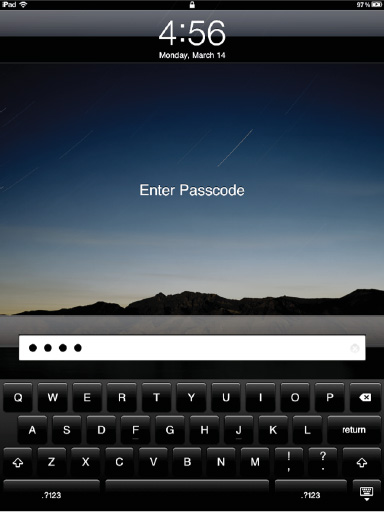
Figure 4.5. The passcode lock screen displaying the keyboard for you to enter a complex passcode on. A simple passcode will show a number pad.
To remove the passcode from your iPad, go back to the Passcode Lock settings screen (Figure 4-4). Choose Turn Passcode Off, and reenter the passcode one more time to confirm that it's really you making this request.
So, what happens if you lose your passcode or a mean-spirited colleague adds one to your iPad without telling you? You'll need to connect the iPad to your home computer and use iTunes to restore the iPad software. You can restore your iPad by selecting the Summary tab in iTunes and clicking Restore. For more information about restoring your iPad, see Chapter 2.
On the lock screen, to the right of the Slide to Unlock bar, you'll notice there is a small icon of a flower inside a box (see Figure 4-3). This is the Picture Frame button. Tap this to turn your iPad into a digital picture frame. The iPad will display your photographs one after the other on the screen until you choose to stop it by tapping the screen and tapping the Picture Frame button again or sliding the Slide to Unlock bar. You'll learn more about the picture frame function of the iPad and its settings in Chapter 13.
The lock screen can also perform one last function: controls for the iPad's music player. If music is playing on the iPad when the screen is locked, you can double-press the Home button to display music controls at the top of the screen. You'll learn more about these controls in Chapter 7.
As discussed, when you turn on your iPad, you'll be presented with a lock screen. Depending on whether you have a passcode set on your iPad, either you'll swipe the Slide to Unlock bar and be presented with a numeric or qwerty keypad or you'll be immediately taken to your iPad Home screen.
The iPad Home screen (see Figure 4-6) is the first page of apps you have on your iPad. Depending on how many apps you have, you may have several pages that will show in subsequent order when you swipe to the left.
Tip
Since the Home screen will be the first page you're taken to when you unlock your iPad, it makes sense to keep your most frequently used apps on the Home screen for easy access.
From the top of the screen down, you'll see the following elements:
Status bar: A thin, black bar runs along the top of your iPad Home screen. This status bar, shown in Figure 4-7, will display on every page of your iPad Home screen.
The status bar can show many icons, but the standard layout you'll most likely see is the following: in the upper-left corner, you'll see the word iPad or iPad 3G (depending on which model you have), next to a Wi-Fi icon. The Wi-Fi icon shows you that you are connected to a wireless hotspot and also tells you the strength of your wireless signal. If you have an iPad 3G, you'll also be presented with the name of your 3G service carrier. In the middle of the status bar, you'll be presented with the current time. On the right corner of the status bar, you'll see a battery meter icon, next to the percentage of the battery remaining.
The status bar can also show other status icons. These include the following:
Airplane mode: With airplane mode, you can't access the Internet or use Bluetooth. Other functions of your iPad are available.
E: This stands for EDGE, a cellular data network that's slower than 3G. Many times E will appear when you are outside your 3G network. You can connect to the Internet using EDGE; just keep in mind it's slower than 3G (available on iPad Wi-Fi + 3G only).
o: This little symbol stands for GPRS. If 3G is a race car and EDGE is a bicycle, GPRS is a turtle. Think 1994 dial-up slow (available on iPad Wi-Fi + 3G only).
Activity: The activity icon looks like a sun. You'll see the activity icon whenever network activity (such as downloading data) is occurring on your iPad.
VPN: This shows you are connected to a virtual private network (VPN). Many companies use VPNs so you can log in securely to their e-mail systems or private networks from your home.
Lock: This padlock tells you your iPad is locked. You'll only ever see this icon on the lock screen.
Screen Rotation Lock: This signifies that the screen rotation is locked. See Chapter 3 for more details.
Play: This icon tells you a song, podcast, or audiobook is playing.
Apps page: Below the black status bar you'll see a series of app icons (see Figure 4-8). Each page can hold up to 20 apps in addition to the ones found in the Dock. As we'll discuss shortly, apps can be deleted and rearranged without the need to plug your iPad into iTunes.
Page dots: Just above the app icons in the Dock, you'll see a series of small, white dots (see Figure 4-9). This series of dots begins with a tiny magnifying glass. We'll get to the magnifying glass shortly. The dots next to the magnifying glass signify the number of pages of apps you have on your Home screen. If you see five dots, it means you have five pages of apps. The dot that is the brightest signifies the location of the page you are currently on among all your pages of apps.
The dock: At the bottom of every page of the Home screen is a long, gray slate known as the Dock (see Figure 4-10). The Dock can contain up to six apps. No matter what page of apps you swipe to, the Dock will always show the same apps. The advantage of this is that if you have ten pages of apps but frequently check your e-mail, no matter what page of apps you're on, you'll always have quick access to your Mail app if you've placed it in the Dock.
Note
Unlike with some apps, no matter if you are holding your iPad vertically or horizontally, all the elements of the Home screen, including how you interact with it, always remain the same.
There are several ways you can interact with your iPad Home screen.
Navigating the apps pages: If you are on your first page of apps, swipe your finger to the left to reveal the next page of apps. Keep swiping your finger to the left to proceed navigating through all your app pages. To go back to the previous page of apps, simply swipe your finger to the right. Alternately, you can drag your finger to the left or right to go for the slow reveal of the next page of apps.
Note
The pages of the Home screen move only left or right. Unlike in many apps, they do not move up or down.
Launching apps: To launch an app, simply tap its icon. To return to the Home screen, press the round, physical Home button on the iPad's bezel.
Manipulating app icons: This is fun. Let's say you want to rearrange the icons on your Home screen, but aren't near your computer to do it through the iPad's iTunes preferences page that we discussed in Chapter 2. Simply touch and hold any icon on the Home screen. After a few seconds, you see all the icons on the page start to jiggle like they're little mounds of gelatin (see Figure 4-11). You can now remove your finger from the app. The icons will continue to jiggle. While jiggling, you can touch and hold any app icon and then simply drag it to a new position on the page. You can also drag icons to and from the Dock.
You can go ahead and swipe to a new page of apps while they are all jiggling and rearrange the apps on that page. You can also transfer apps between pages. Simply touch and hold the app you'd like to move to a different page and drag it toward the side of the screen where the page is located. After a brief pause, the next page will automatically swipe over, and you can drop the app anywhere you want it. If that page is already full of 20 apps, the app in the lower-right corner will be pushed to the next page automatically.
Note
If your Dock already has six apps on it, you must remove an app first before adding a new one to the Dock. Unlike with home pages, apps in the Dock will not automatically be pushed to a new page if you try to add a new app to a full Dock.
Creating folders of apps: In Chapter 2 we talked about how to create folders full of apps on your iPad using iTunes, but you can also create folders of apps right on your iPad. Simply touch and hold an app icon until all the apps are jiggling (see Figure 4-11). Once they are, drag an app onto another app icon and hold it there. After a second or two, an app folder will appear. Drop the app inside the folder so it appears next to the app icon you held it over (see Figure 4-12).
You can arrange the apps in this new folder any way you want. You can also name the folder whatever you want. A cool thing Apple did was give the folder the ability to guess the name you want it to be. In the example in Figure 4-12, we created a folder with two movie apps inside. The iPad knew both apps were entertainment-related and named the folder Entertainment, appropriately. You can always change the name of the folder, however. Tap anywhere outside the folder to return to the normal apps screen. Drag any app to an existing folder to add it to that folder.
Folders appear as gray boxes with multiple app icons inside (see Figure 4-13). Folders can contain up to 20 apps and you can have up to 26 folders on a page (20 on a page plus 6 folders can be stored in the dock). To open a folder, simply tap it, and its contents will expand while the rest of the outside app icons are grayed out (see Figure 4-13). To exit a folder, tap anywhere outside of it.

Figure 4.13. Left, an apps page with two folders, Entertainment and Medical. Right, the same apps page with the Entertainment folder open.
Removing apps: In Chapter 2 we told you how to remove apps from your iPad using iTunes. You can also remove an app from the iPad right on the iPad. To do this, simply touch and hold any icon on the Home screen and wait for them all to begin jiggling like they did when you were rearranging apps (see Figure 4-14).
Notice how some of the apps have a little black and white X in their upper-left corner? Tapping that X will delete the app. Don't worry if you accidentally delete an app from your iPad. The apps are always store in your iTunes library, and you can reinstall them at any time.
Note
You cannot delete any Apple apps that were factory installed on your iPad. You can, however, delete Apple apps that you installed yourself, such as Pages, iBooks, Numbers, and Keynote.
To delete an app, simply touch the X. A pop-up will appear on the screen asking if you want to delete the selected application. You'll also see a note saying deleting the app "will also delete all of its data," as shown in Figure 4-15. This is important! If you've created a new document inside the app or achieved a new high score on a game and delete the app before syncing it to iTunes, any new data associated with that app will be deleted. So, if you've created a new documents in Pages and decide to delete the Pages app, your new document will be forever lost if you don't sync your iPad before deleting Pages. Any documents the Pages app contained before the last sync will be available to you again if you resync the Pages app from iTunes.
Note
If you delete an app accidentally and need it back right away but are not near your computer, you can simply use the iPad's built-in App Store app to download the app again. If it was a paid application, don't worry; you won't be charged a second time. Your iTunes account will know you've already paid for it.
If you are sure you want to delete an app, go ahead and tap the Delete button. If you've changed your mind, tap Cancel. When an app is deleted, all the other apps on the page will shift one position to fill the space of the deleted app.
With iOS 4, Apple introduced multitasking features to the iPod touch. Multitasking means you can have more than one app running at a time. In other words, you could be browsing the Web in Safari, but in the background you could have an instant messaging app running. Even though your entire iPad's screen would be devoted to the Safari app, you would still be online and notified of new instant messengers in the IM app.
As we've mentioned before, to leave an app, you press the Home button to return to the home screen, and then you find the next app that you want to launch and tap its icon. With the multitasking features built into iOS 4, you don't have to return to the home screen every time you want to launch a different app. Now, no matter what app you are in, pressing the Home button twice will bring up a row of all the apps that are currently running in the background (see Figure 4-16). These apps are referred to as background apps. Any app you have launched on the iPad since turning it on will run as a background app until you close the app for good (discussed in a few pages). This background app bar is a very handy feature, but there is one small caveat: all the apps you see there might not actually be running in the background. Apple also uses this bar to show recently used apps, so even after a reboot, you might see several apps in the bar even though you have not launched them since rebooting.

Figure 4.16. Some apps that are running in the background while we are currently in the Cut the Rope game.
In Figure 4-16, you can see we are in a fun game called Cut the Rope. By double-pressing the Home button twice, the multitasking bar slides the screen up, and you can scroll through all your other open, or background, apps. To see more currently running background apps, slide your finger over the row of apps. To quickly switch to another background app, tap its icon, and it will swap places with the current app you are in (see Figure 4-17).
The iPad's home screen allows you to launch any application with a single tap. Once you've launched that app, it remains open in the background even if you return to the Home screen. To close the app for good, double-press the Home button to open the background apps bar. Swipe through the row of apps until you've found the one you want to close. Now touch and hold the app's icon until it and the other apps in the bar start to jiggle. You'll notice red circles with white minus signs have appeared in the corner of all the apps in the bar (see Figure 4-18). Tap the red circle to close the app. To reopen the app, you'll need to launch it from the home screen again.
Quitting applications instead of letting them remain open in the background lowers your CPU usage, keeps your iPod slightly cooler, and puts a little less strain on your battery.
Remember how we mentioned that Apple also uses this background multitasking bar to show recently used apps? Well, if the app isn't running, tapping the minus sign will remove the recently used app from the bar. The way Apple has this implemented, you can't really tell just by looking through the bar which apps are running and which are just recently used apps.
The iPad's Home screen allows you to launch any application with a single tap. When in an app, press the iPad's Home button to return to the Home screen at any time. If, for some reason, a program hangs and your iPad becomes unresponsive, you can press and hold the Home button for six to ten seconds to quit that program and return to the Home screen.
Tip
A Back button appears in the upper-left corner of many iPad screens while inside an app. Tap this button to return to the previous screen in the app. This is different from pressing the Home button. The Back button moves you between screens within an app. The Home button leaves an app and returns you to the Home screen.
At this point, you've explored everything the iPad Home screen offers save one important feature. Earlier we mentioned a small gray magnifying glass icon next to the row of dots that represent the pages of apps that you have (see Figure 4-19). This magnifying glass icon represents the iPad's powerful search feature, named Spotlight.
To access Spotlight, simply swipe to the right of the first page of your Home screen. You'll be taken to a page that displays a small, white search field at the top with the words Search iPad in it. At the bottom of the page, you'll be presented with the built-in keyboard.
Simply begin typing any search query into the search field and the space between the search field, and the keyboard will begin populating with results (see Figure 4-20).
At this time, Spotlight isn't as powerful as it can be. If you own a Mac, you'll know that Spotlight is capable of searching in documents, not just by a document's file name. Currently, Spotlight is only capable of searching the following:
Mail: To, From, and Subject fields.
Calendar: Event titles, invites, and locations.
iPod: Song names, artists, and albums. Podcast and audiobook titles and names.
Notes: Interestingly, although Spotlight can't search the text in the body of an e-mail message, it can search the text in a note from the Notes app.
To select a result, simply tap it, and you'll automatically be taken to the document or file in the app it's found in. At the bottom of the Spotlight results you have the option to search the Web for your query and also search Wikipedia. Tapping either of those options will open the Safari web browser and take you to your default search engine page or the Wikipedia search results page.
Although Spotlight is a nice feature, it does have some limitations. Perhaps the biggest limitation is that you can't search for text in the body of an e-mail. Also, Spotlight isn't smart enough to recognize misspellings, so anything that is mistyped in a note or e-mail subject won't be found.
Note
If you have dozens and dozens of apps, instead of swiping through all the Home screen pages, you can simply go to Spotlight and search for the name of the app. When its icon appears, simply tap it to launch it.
The iPad has myriad settings allowing you to customize how your iPad works and looks. You can find all of these settings in the Settings app on your iPad Home screen (Figure 4-21).
Tap the Settings app, and on the left side of the screen, you'll see a list of settings for the iPad and any Apple iPad apps that shipped with the iPad (see Figure 4-22). Below those, you'll see an Apps heading. Any apps you've downloaded from the iTunes Store will appear here if they have customizable settings. To select an app's setting, tap the name of the app.
Although we'll go into greater depth about Apple's built-in app's individual settings throughout the book, for now let's get acquainted with the iPad's General settings.
About: This shows you how many songs, videos, photos, and applications you have on your iPad. It also shows you your iPad's total storage capacity and how much you have left. Your iPad's OS version number, model, and serial numbers can be found here, along with your Wi-Fi and Bluetooth IDs. At the very bottom, you'll see links to Apple's legal and regulatory documentation.
Sounds: This area gives you a slider to adjust the volume on your iPad and set your ringtone. It also enables you to turn on or off sounds for e-mail, calendar alerts, lock sounds, and keyboard clicks.
Network: This displays your network settings. See Chapter 3 for details.
Bluetooth: This allows you to turn the iPad's Bluetooth signal on or off. If you aren't using any Bluetooth devices with your iPad, keep Bluetooth turned off. It'll save you battery life.
Spotlight Search: The settings for iPad's Spotlight search features.
Auto-Lock and Passcode Lock: As we talked about earlier, this is where you configure your lock settings.
Restrictions: If you share your iPad among your family or buy one for your children, you may want to limit what they can do on it. The Restrictions settings will let you limit access to Safari, YouTube, and the iTunes Store app. In addition, you can restrict users from installing new apps and using location services. You can also choose what content you want allowed on the iPad. Settings include restricting In-App purchases and limiting access to movies, music, TV shows, and apps that surpass your chosen ratings.
Use Side Switch To: Set the function of the iPad's physical side switch. Choose from between making it a rotation lock witch or a mute switch.
Date & Time: This allows you to select a 24–hour clock as well as set your time zone and set the date and time manually.
Keyboard: This is where you control all your keyboard settings. We'll go through them in the next section.
International: Use this settings pane to select your preferred language and region formatting for addresses and phone numbers.
Accessibility: This is where the settings for the sight and hearing impaired are. We'll go into these in detail later in the chapter.
Battery Percentage: Choose whether to display the percentage of battery power you have left next to the icon of the battery in the status bar.
Reset: Reset All Settings lets you set your iPad's settings to factory default. Erase All Content and Settings works like Reset All Settings but also erases all your personal data. This section also allows you to reset your network, keyboard, Home screen layout, and location settings to the iPad's factory defaults.
Like the touch keyboard on your iPhone? You haven't seen anything yet. Using the iPad's keyboard for the first time is nothing short of an epiphany when you realize what a large-screen, Multi-Touch device is capable of.
The keyboard, shown in Figure 4-23, will display automatically when you are in any app that needs to have text input. It is important to note that the software keyboard will not display if the iPad is paired to an external Bluetooth keyboard. (Refer to Chapter 3 for Bluetooth pairing.)
For this section, we'll look at using the onscreen keyboard in Apple's Notes app that comes on every iPad.
Open Notes, and click the + button in the upper-right corner to create a new note. At the bottom of your iPad's screen, you'll see the keyboard automatically appear (see Figure 4-24).
Note
Using the keyboard in portrait orientation gives you a smaller keyboard, but more space to see what you're typing onscreen. If you switch to landscape orientation, you'll have a larger keyboard but less space to see what you've typed. Play around to see what works best for you.
Though Apple has outdone itself in designing the iPad's keyboard, many people still think it's the hardest thing to get used to on their new iPad. Making the switch to a touch screen keyboard can be difficult, but it does get much better over a relatively short amount of time. The keyboard gets easier to use the more you use it, not just because you get used to it, but because it has a secret.
The secret is that the keyboard, shown in Figure 4-23, is smart—so smart that it corrects for a lot of typos and misaligned fingers. It automatically capitalizes the start of sentences. It suggests corrections for misspelled words. It uses predictive technology to make it easier to hit the right keys. So, within a few weeks, you'll master the keyboard's quirks. You can also use Apple's iPad Smart Cover (mentioned in Chapter 1) to give the iPad a better angle for typing. A cover folds back into a triangle and forms a wedge that tilts the iPad at a comfortable angle so you can type and look at the screen above the keyboard at the same time. The angle of the case makes it easier to avoid mistakes touch-typists make on the iPad's onscreen keyboard, namely, resting palms and fingers on the screen.
Here are some of the key technologies that make the iPad keyboard work:
Dictionary: The iPad has a built-in dictionary that learns frequently used words as you type (see Figure 4-25). It also picks up names and spellings from your address book. This means it gets better at guessing your intentions as it builds its data.
Automatic correction: As you type, the iPad looks for words similar to what you're typing and guesses them, placing the guess just below the word you're typing (see Figure 4-26). To accept the suggestion, just tap the spacebar, and the full word is inserted.
Spell check: If you do spell a word wrong or the iPad doesn't recognize it, you'll see a red line appear below the word. When you tap the word, one or more alternate spellings will appear above it (see Figure 4-27). Simply tap the right word, and it inserts itself into the text.
Predictive mapping: The iPad uses its dictionary to predict which word you're about to type. It then readjusts the keyboard response zones to make it easier for you to hit the right letters. Likely letters get bigger tap zones; unlikely letters get smaller ones.
Thought the iPad had only one keyboard? Think again. It has more than a dozen (in different languages). It also has two other keyboards you'll frequently access from the primary keyboard on your screen.
On the primary keyboard (shown earlier in Figure 4-23), you'll notice the comma, exclamation point, question mark, and period next to the Shift key. Below that is the .?123 key (in some applications it's the @123 key). Tapping the .?123 key automatically switches your QWERTY keyboard into a numeric keyboard with further punctuation symbols, an "undo" option, and another keyboard modifier key labeled #+= (see Figure 4-28).
Tip
You don't need to use the "undo" button to undo something. You can simply shake your iPad. (Not too hard! You don't want to look like you've lost your marbles!) An undo pop-up will appear on the screen giving you the option of undoing your last action or canceling the undo.
Tapping the #+= key takes you to a third keyboard with more punctuation and a "redo" button (see Figure 4-29). Redo, if the app supports it, will repeat the last action performed. So if you've copied and pasted text, tapping the redo button will paste the text again.
When you're new to the iPad, start by typing slowly. Typing with the iPad in your hands can be difficult because of the device's size. For optimal typing experience, place the iPad on a table or prop it in your lap. At first, you may be typing by using your index fingers on each hand, but the more you use it, the more you'll typing as you do on a physical keyboard. Whatever method you use, make sure to go at a pace that allows you to keep track of what you're typing and make corrections as you go. Here are a few typing how-to's:
Summoning the keyboard: To open the keyboard, tap in any editable text area.
Dismissing the keyboard: To make the iPad's keyboard go away, tap the bottom-right key (you can see the key in Figures 4-23, 4-28, and 4-29). It's the button with the picture of a keyboard and a down arrow on it. To get the keyboard back, simply tap in any editable text area again.
Accepting or rejecting automatic corrections: The iPad displays suggested corrections just below the word you're typing, as shown earlier in Figure 4-25. To accept the suggestion, tap the spacebar. (You don't need to finish typing the word; the iPad puts it in there for you.) To decline the correction, tap the word itself. The iPad will not make a substitution, even when you press the spacebar.
Using the spyglass: While you're typing, you can adjust the cursor by using the iPad's built-in spyglass feature, as shown in Figure 4-30. Hold your finger somewhere in the text area until the spyglass appears. Then use the magnified view to drag the cursor exactly where you need it.
Note
If you are going to be doing a lot of typing on your iPad (like writing a book, for instance), you may want to look into getting the iPad Keyboard Dock or the Apple Bluetooth keyboard we told you about in Chapter 3. A physical keyboard turns the iPad into more of a traditional computer. Plus, if you are a touch-typist, you'll probably type much faster on a physical keyboard because you can feel its presses and hear its clicks. You aren't limited to an Apple Bluetooth keyboard either. Several third-party keyboards work with the iPad. Contact the manufacturer to find out what their Bluetooth keyboards do.
Once you get the hang of the keyboard, the iPad offers several other ways to make typing easier. This section describes a few of these handy iPad typing tricks.
When you want to type a contraction like can't or shouldn't, don't bother putting in the apostrophe. The iPad is smart enough to guess that cant is can't (Figure 4-31). Of course, if you're typing about the British Thieves' language, make sure to tap the word to decline the change from the noun to the contraction.
When you're typing in a word like we'll, where the uncontracted well is a common word, add an extra l. The iPad corrects welll to we'll and shelll to she'll.
When at the end of a sentence, tap the punctuation key, then tap the item you want to use (such as a question mark or period), and finally tap the spacebar. The iPad is smart enough to recognize the end of a sentence and put you back in alphabet mode. During normal typing, you can also double-tap the spacebar to add a period followed by a space. This double-tap trick is controlled in your settings via Settings
Tap and hold any keyboard letter to view inflected versions of that letter. For example, tapping and holding e presents the options of adding e, é, or ê (among other accents), as shown in Figure 4-32. This shortcut makes it much easier to type foreign words. To select a non-English keyboard, go to Settings
When you press and hold the Delete key, the iPad starts off by deleting one letter and then the next. But if you hold it for longer than about a line of text, it switches to word deletion and starts removing entire words at a time.
Autocapitalization means the iPad automatically capitalizes the word at the beginning of a sentence. So, you can type the day has begun, and the iPad is smart enough to capitalize the, as in, The day has begun. This means you don't need to worry about pressing the Shift key at the beginning of every sentence or even when you type i, because i went to the park becomes I went to the park. Enable or disable autocapitalization in Settings
Apple has created an easy and intuitive way to select a word or block of words, copy them, and then paste them into another location.
Let's copy some text from a web page in iPad's Safari web browser. Before you can copy a word, you'll need to select it. To do that, press and hold your finger over a word. A black contextual menu will pop up that gives you the Select and Select All options. Select will highlight just the single word. Select All will highlight all the words on the page. No matter which you choose, you'll be presented with a grab point at the beginning and end of the selected text (see Figure 4-33). These grab points allow you to adjust which text is selected.
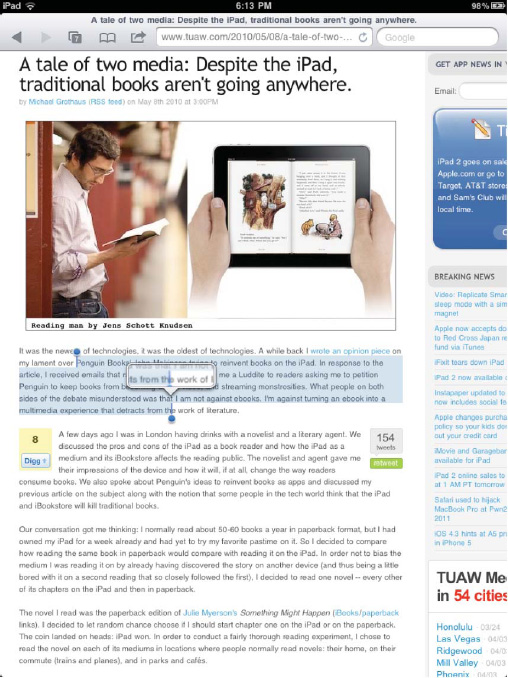
Figure 4.33. Grab points allow you to select a single word, a sentence, or a whole paragraph to be copied.
Note
If you've selected text to copy in an editable document, you'll see a contextual menu that says Cut, Copy, or Paste. Selecting Cut will remove the text. Selecting Copy will copy it, and if you already have text copied, you'll be able to paste it over your current selection.
Once you have selected your text, you'll see another contextual menu that says Copy. Tapping Copy will copy the text and make it available in any app that support text input.
Now let's go back to the note in the Notes app. To paste the text you copied from Safari into your note, simply press and hold your finger on the screen until the spyglass pops up. Use the spyglass to adjust the cursor to the location where you want to insert the copied text and let go. You'll see another contextual menu pop up that gives you three options: Select, Select All, and Paste. Tap Paste, and your copied text will be instantly inserted (Figure 4-34).
As mentioned earlier, the iPad's keyboard sports undo and redo buttons. Tapping the undo button undoes the last action you performed. So if you've copied and pasted text, tapping the undo button will unpaste the text but leave it copied on your clipboard. Remember that you can also shake your iPad to display an undo pop-up that will ask you whether you want to undo the last action you performed.
Redo, if the app supports it, will repeat the last action performed. So if you've copied and pasted text, tapping the redo button will paste the text again.
Apple wanted to make sure everyone could use the iPad as easily as possible. To that end, Apple offers accessibility features to help people with disabilities use the iPad. We briefly touched on the iPad's accessibility options in the iPad iTunes settings pane in Chapter 2. The iPad features more accessibility options than the ones you see in the settings pane, however. To see all the accessibility options, tap the Settings icon on the iPad's Home screen. Under General settings, tap Accessibility. You'll see the Accessibility settings slide onto the screen (see Figure 4-35). Let's go through these settings one by one.
With VoiceOver turned on, the user can simply touch the screen to hear a description of what is beneath his finger. They can then double-tap to select the item. With VoiceOver enabled, the iPad will speak when the user has a new e-mail message and can even read the e-mail to the user.
Zoom allows those hard of seeing to magnify their entire screen. This is different from the standard pinch and zoom features of the iPad's regular software. Accessibility Zoom will magnify everything on the screen, allowing the user to zoom into even the smallest of buttons. When this option is selected, the user can double-tap any part of the iPad's screen with three fingers to automatically zoom in 200 percent. When the screen is zoomed in, you must drag or flick it with three fingers. Also, when you go to a new screen, zoom will always return to the top middle of the screen.
This lets you increase the size of text in Contacts, Mail, and Notes. You can choose from 20-point text, 32-point, 40-point, 48-point, and 56-point.
For some people with seeing difficulties, inverting the color of a computer screen so it resembles a photographic negative allows them to read text better. Turning White on Black does this.
With Mono Audio selected, the stereo sounds of the left and right speakers will be combined into a mono (single) signal. This option lets users who have a hearing impairment in one ear hear the entire sound signal with the other ear.
With this option selected, any autocorrection text (like the spell-check pop-ups that appear when you are typing) will be spoken aloud.
If you are sharing an iPad in a house with someone with disabilities, selecting this option will allow users, by triple-clicking the iPad's physical Home button, to quickly toggle VoiceOver, Zoom, or White on Black on or off (Figure 4-36). You can also set it so triple-clicking the Home button causes a pop-up to appear onscreen asking what accessibility feature to turn on.
Note
With the exception of the triple-click Home feature, all of these accessibility settings can also be configured from within the iPad iTunes settings pane on the Summary tab (see Chapter 2).
This chapter explored all the ways you can interact with your iPad, from taps to buttons to pinches. You read about the touch screen and how you can communicate with it. You discovered how to access your Home screen, how to lock it, and how to rearrange its icons. You explored your iPad's General settings, and you learned tips and tricks to using the iPad's virtual keyboard and setting accessibility options. In short, you were introduced to all the basic ways you and your iPad can communicate with each other. Here are a few key lessons for you to carry away with you:
Build up your working iPad interaction vocabulary. You will be surprised how often one of the rarer gestures, like the two-fingered tap, can prove useful.
If you are using your iPad in an area where your data's security is an issue, be sure to set a passcode lock.
Spotlight is a powerful search tool on the iPad and offers you another way to quickly launch your apps.
The iPad supports more than a dozen keyboard languages as well as physical hardware keyboards.
Don't worry about typing perfectly on the iPad. Its smart keyboard will correct most of your mistakes automatically.
Just because you have a disability doesn't mean you can't use the iPad. The iPad has many accessibility features to help the those with sight or hearing issues.


